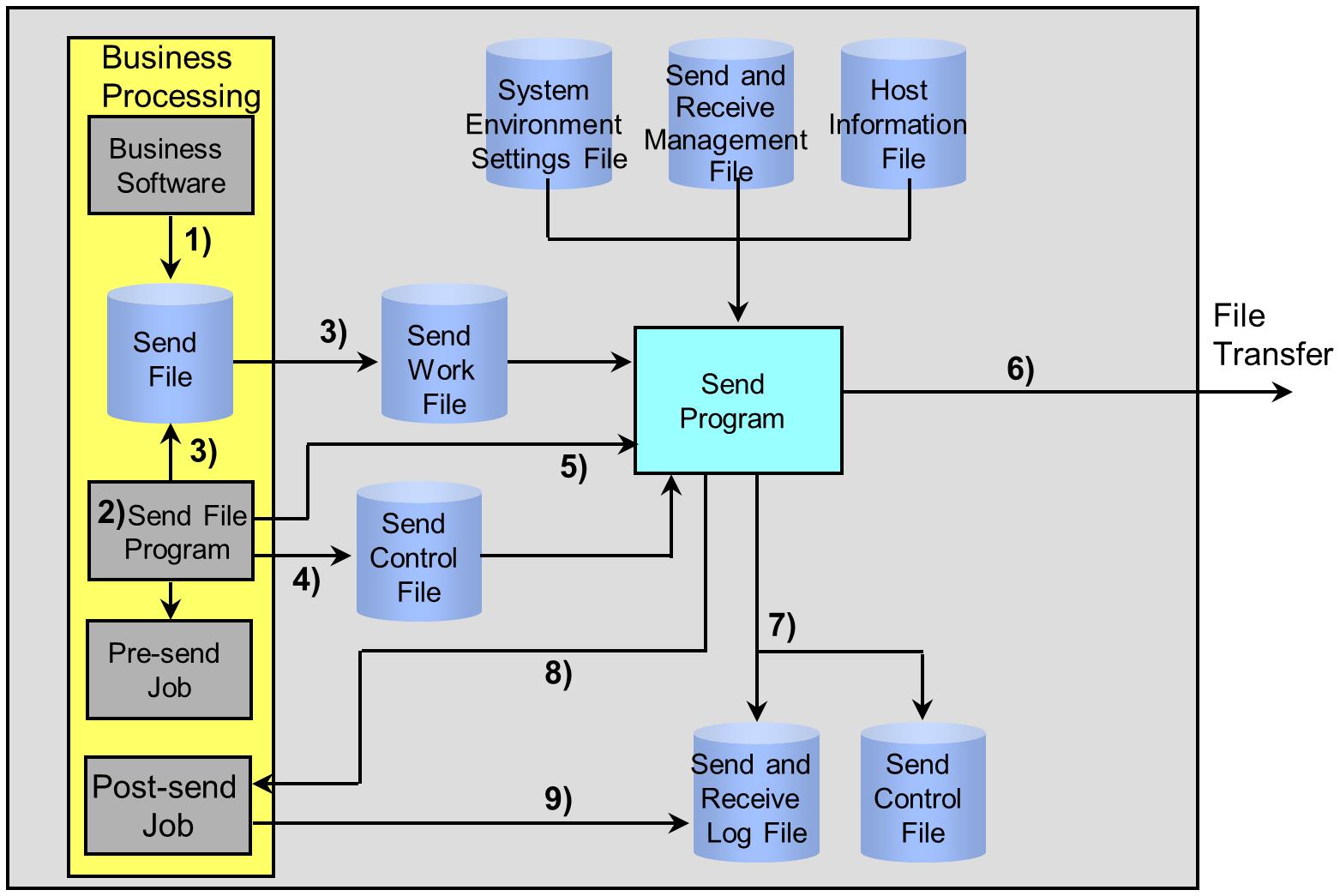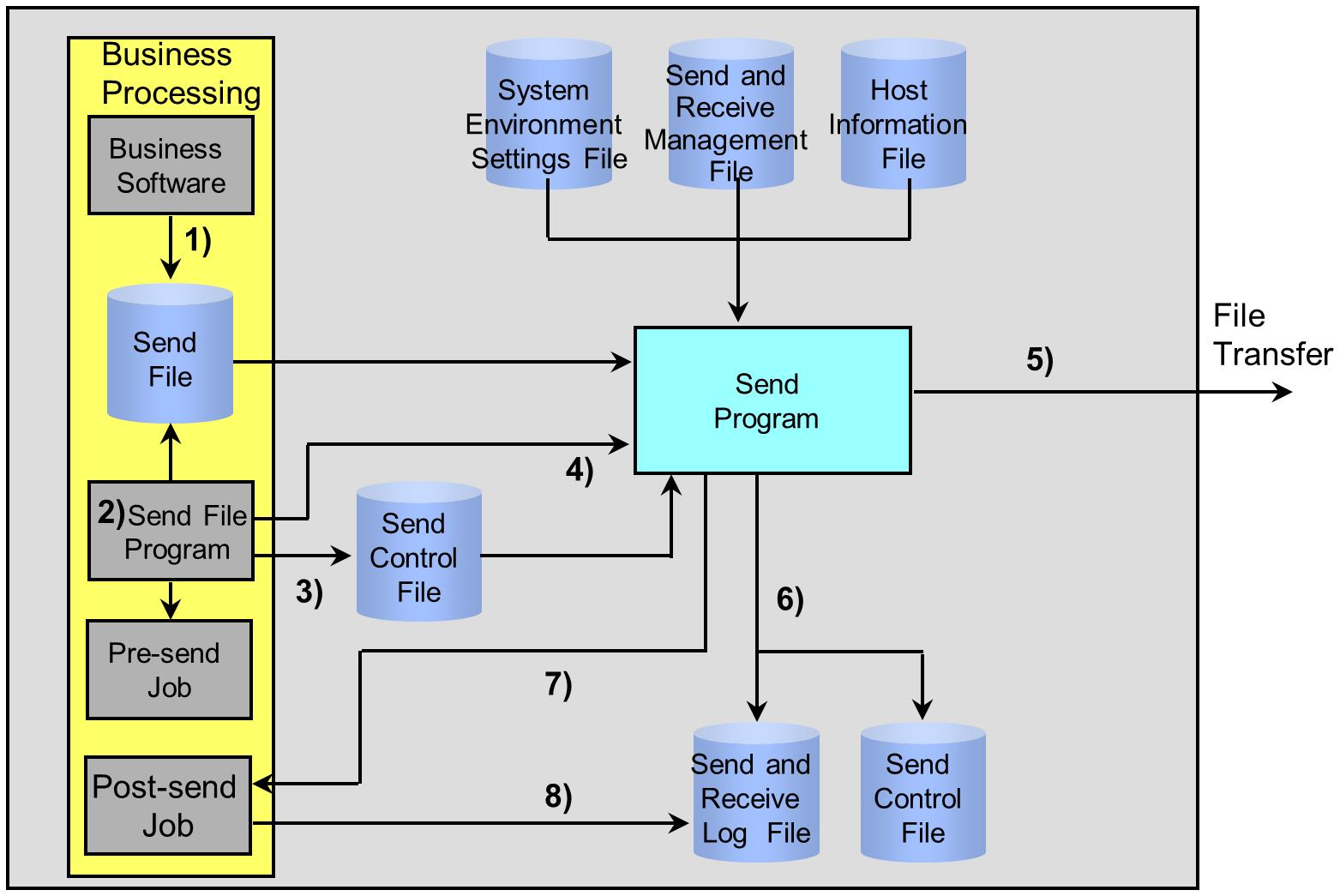Flow of sending
In sending, files are sent from the host on the sending side to specified hosts.
Run the Send File program (XRSNDGO) to start the Send processing on the host on the sending side. The request to carry out the Send processing by executing the Send File program (XRSNDGO) is called 'Send File' in HULFT.
This processing requires the Send program (XRSND) on the host on the sending side and the Receive program (XRRCV) on the host on the receiving side to have already been run.
The flow of sending when file transfer is started on the host on the sending side is illustrated in Figure 2.1 and Figure 2.2 .
Sending with Work File Transfer
2) Running of Send File program (XRSNDGO)
Sending is started when you run the Send File program (XRSNDGO) on the host on the sending side. You can also start sending by executing the Send File on the HULFT Management Console.
You can automatically start sending by incorporating the Send File program (XRSNDGO) into the business batch jobs that are mentioned in 1) .
When a Pre-send Job is specified in the Send Management Information, HULFT executes the job before HULFT starts the Send processing.
3) Creation of Send work file
The Send File program (XRSNDGO) carries out code conversion and compression of the Send file according to the settings that are registered in the Send Management Information, and writes the data of the Send file to the Send work file.
Make sure there is enough space on the disk to create work files.
-
If you carry out the Send processing using the Direct Transfer, HULFT does not create Send work files. Therefore, you do not have to pay attention to the capacity of the disk.
-
Operation when work files are created differs depending on the setting of the UNIT Quantity (UNIT-CNT) in the Send Management Information. The differences in operation depending on the settings are as follows:
-
Case where '1' is set as the UNIT Quantity
The work file is not cataloged.
-
Case where '2' or higher is set as the UNIT Quantity
The work file is cataloged.
-
4) Writing of record in Send Queue
The Send File program (XRSNDGO) writes the information required for the Send processing (the record in the Send Queue) to the Send Control file (HULFT.QUEUE). HULFT gives each record in the Send Queue a sequential number (Send SEQ No.) to identify the transfer.
5) Order for sending file
The Send File program (XRSNDGO) orders the Send program (XRSND) to send the file.
6) Carrying out of Send processing
The Send program (XRSND) transfers the data of the Send work file to the remote host according to the information in the record in the Send Queue.
7) Writing of Send Log record
After the Send processing ends, the Send program (XRSND) writes the Send Log record to the Send and Receive Log file (HULFT.LOG).
If the Send processing ends unsuccessfully, the Send program (XRSND) writes the information of the transfer that terminated unsuccessfully (the record in the Resend Queue) to the Send Control file (HULFT.QUEUE). HULFT gives each record in the Resend Queue a sequential number (Resend Queue List No.) to identify the transfer.
8) Startup of Post-send Job
The Send program (XRSND) starts the Post-send Job according to the settings that are registered in the Send Management Information. In the Send Management Information you can register both a successful job to be started when the Send processing ends successfully, and an unsuccessful job to be started when the Send processing ends unsuccessfully. HULFT starts one of the two types of jobs depending on the transfer result.
9) Writing of job execution log record
The job steps, incorporated by HULFT into the Post-send Job, will write job execution log records to the Send and Receive Log file (HULFT.LOG).
-
HULFT does not write the execution log record of the Pre-send Job to the Send and Receive Log file (HULFT.LOG).
-
HULFT does not execute the Pre-send Job for the Resend File.
Sending using Direct Transfer
2) Running of Send File program (XRSNDGO)
Sending is started when you run the Send File program (XRSNDGO) on the host on the sending side. You can also start sending by executing the Send File on the HULFT Management Console.
You can automatically start sending by incorporating the Send File program (XRSNDGO) into the business batch jobs that are mentioned in 1) .
When a Pre-send Job is specified in the Send Management Information, HULFT executes the job before HULFT starts the Send processing.
3) Writing of record in Send Queue
The Send File program (XRSNDGO) writes the information required for the Send processing (the record in the Send Queue) to the Send Control file (HULFT.QUEUE). HULFT gives each record in the Send Queue a sequential number (Send SEQ No.) to identify the transfer.
4) Order for sending file
The Send File program (XRSNDGO) orders the Send program (XRSND) to send the file.
5) Carrying out of Send processing
The Send program (XRSND) carries out code conversion and compression of the Send file according to the information in the record in the Send Queue, and then transfers the data of the Send file to the remote host.
6) Writing of Send Log record
After the Send processing ends, the Send program (XRSND) writes the Send Log record to the Send and Receive Log file (HULFT.LOG).
If the Send processing ends unsuccessfully, the Send program (XRSND) writes the information of the transfer that terminated unsuccessfully (the record in the Resend Queue) to the Send Control file (HULFT.QUEUE). HULFT gives each record in the Resend Queue a sequential number (Resend Queue List No.) to identify the transfer.
7) Startup of Post-send Job
The Send program (XRSND) starts the Post-send Job according to the settings that are registered in the Send Management Information. In the Send Management Information you can register both a successful job to be started when the Send processing ends successfully, and an unsuccessful job to be started when the Send processing ends unsuccessfully. HULFT starts one of the two types of jobs depending on the transfer result.
8) Writing of job execution log record
The job steps, incorporated by HULFT into the Post-send Job, will write job execution log records to the Send and Receive Log file (HULFT.LOG).
-
When you dynamically specify the Send file with the Send File program (XRSNDGO) and the following conditions are not fulfilled, HULFT carries out the Work File Transfer:
-
Specification of 'D' (Direct) for the Transfer Mode (DIRECT) setting in the Send Management Information
-
Specification of 'Y' for the Direct Transfer Mode for the Dynamic Specification (DYNAMIC-DIRECT) in the System Environment Settings
-
Specification of 'SHR' for the DISP parameter of the DD statement that specifies the Send file
-
-
HULFT does not write the execution log record of the Pre-send Job to the Send and Receive Log file (HULFT.LOG).
-
HULFT does not execute the Pre-send Job for the Resend File.

